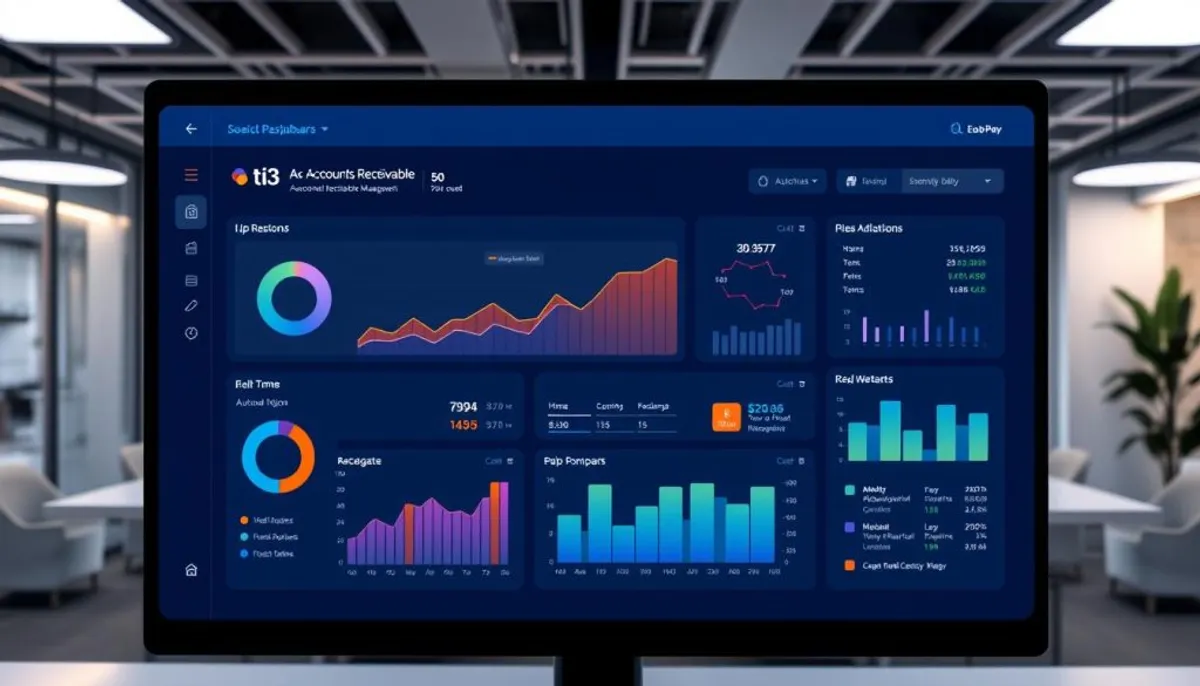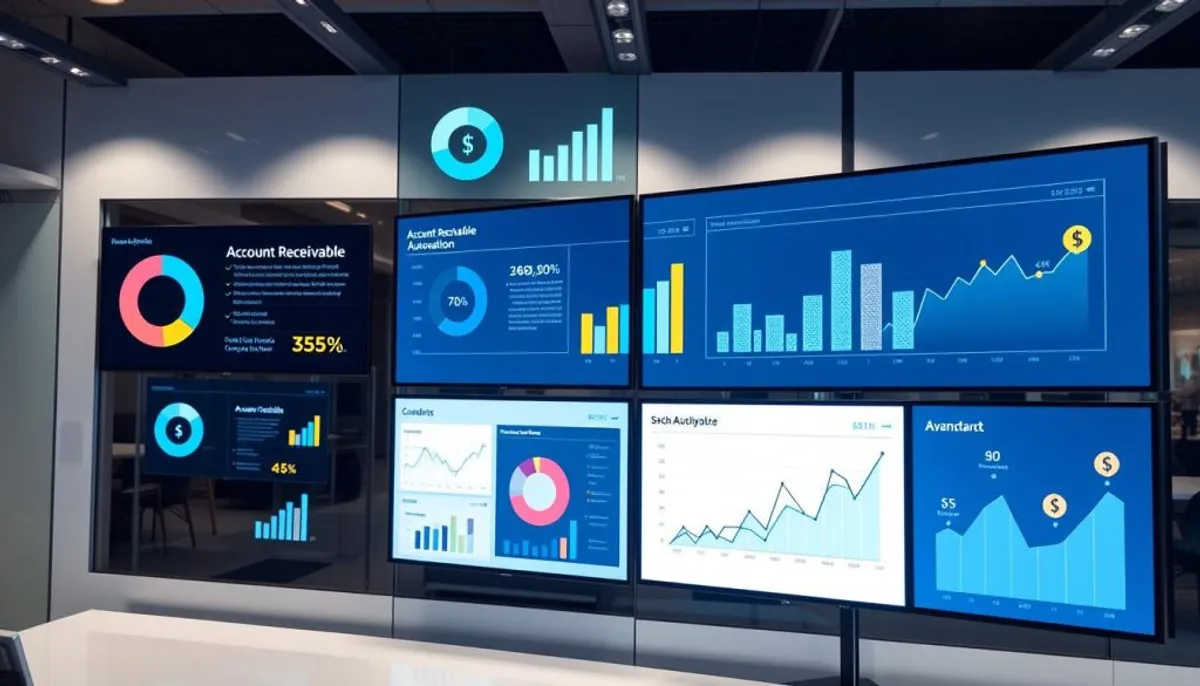Welcome to the realm of accounts receivable automation, a transformative technology reshaping financial management for businesses. This innovation simplifies invoicing, payment tracking, and collections, significantly easing the workload for finance teams. It’s a paradigm shift, ushering in a new era of efficiency.
The era of manual data entry and the tedious pursuit of payments is behind us. Automated AR processing is now at the forefront, enhancing cash flow, reducing expenses, and ensuring customer satisfaction. This technology is a triple win, benefiting both the business and its stakeholders.

Let’s explore the intricacies of AR automation and its profound impact on business finance. This technology is not limited to any particular size or industry, resonating with both small startups and large corporations. Its influence is widespread, marking a significant milestone in the evolution of business operations.
Key Takeaways
- AR automation streamlines invoicing and payment tracking
- It reduces manual work and improves accuracy
- Benefits include better cash flow and lower costs
- Many software options are available for different needs
- Implementing AR automation follows a clear process
- It enhances customer experience and satisfaction
- AR automation is becoming essential for modern businesses
Understanding Accounts Receivable Automation Fundamentals
Receivables automation has transformed financial management for businesses. It streamlines payment collection, cuts down on manual labor, and boosts cash flow efficiency.
Definition and Core Components
Automated accounts receivable processing employs software for tasks like invoice generation, payment tracking, and collections. Key elements include invoicing systems, payment processing tools, and analytics platforms.
Evolution from Manual to Automated Processes
The transition from manual to automated processes is driven by the pursuit of efficiency and precision. Companies adopting receivables automation witness notable enhancements:
- 87% experience quicker overall process speeds
- 75% deliver superior customer experiences
- Businesses handling 20,000+ invoices monthly see payments 23 days sooner on average
Key Technology Drivers in AR Automation
Cloud computing, artificial intelligence, and machine learning are at the forefront of AR automation advancements. These technologies facilitate real-time data processing, predictive analytics, and intelligent decision-making. For instance, Stripe users typically settle invoices within three days, illustrating the efficiency of contemporary automated systems.
By integrating receivables automation, businesses can markedly enhance their financial operations, minimize delays, and elevate customer satisfaction.
The Business Case for Automation of Accounts Receivable
Businesses are increasingly adopting AR automation to enhance efficiency and cash flow. The advantages of AR automation are evident, with quicker invoice processing leading to timely billing and elevated customer satisfaction. Automating invoicing and collection processes minimizes manual data entry and errors, significantly streamlining operations.
The ROI of accounts receivable automation is considerable. Industry data indicates that optimizing Days Sales Outstanding (DSO) to 15 days can liberate 83 days of working capital. This stark contrast to the average 98-day DSO in Western Europe underscores the potential for significant improvements in cash flow management.
- Faster payment processing
- Reduced errors
- Cost savings
- Stronger cash flow
- Improved customer relationships
- Enhanced data insights
To construct a compelling business case for AR automation, consider these pivotal steps:
- Define clear business goals
- Identify current AR process pain points
- Demonstrate financial impact of challenges
- Highlight direct and indirect benefits
- Present an implementation timeline
- Show scalability for future growth
- Engage key stakeholders
- Calculate ROI using tools like Centime’s calculator
- Address potential concerns and objections
| Metric | Before Automation | After Automation |
|---|---|---|
| Average DSO | 98 days | 15 days |
| Manual Errors | High | Minimal |
| Cash Flow | Restricted | Improved |
| Customer Satisfaction | Variable | Increased |
By embracing AR automation, businesses can eliminate bad debt, diminish financial risk, and ensure cash flow certainty. The ROI of accounts receivable automation transcends mere cost savings, offering a competitive advantage in today’s dynamic business landscape.
Essential Features of Modern AR Automation Solutions
Modern AR automation solutions are transforming accounts receivable processes. They introduce a variety of features that enhance efficiency and streamline operations.
Invoice Generation and Processing
At the core of modern AR systems lies invoice automation. These tools autonomously generate and process invoices, significantly reducing human intervention. They extract data from accounting systems, ensuring precision and promptness. This automation minimizes errors and accelerates the billing cycle.
Payment Collection and Reconciliation
Automated billing systems streamline payment collection. They offer diverse electronic payment methods, facilitating customer payments. The system automatically aligns payments with invoices, simplifying reconciliation.
Customer Communication Tools
Effective communication is vital in accounts receivable. Automated invoicing solutions include tools for sending reminders and notifications. These tools keep customers abreast of their payment status and due dates.
Reporting and Analytics Capabilities
Data-driven insights are essential for AR management. Modern solutions offer comprehensive reporting and analytics tools. These tools provide insights into AR aging, cash flow forecasts, and collection performance.
| Feature | Benefit |
|---|---|
| Invoice Automation | Reduces errors, speeds up billing |
| Automated Payment Collection | Improves cash flow |
| Customer Communication Tools | Enhances customer relationships |
| Analytics Capabilities | Provides actionable insights |
By 2028, the EU plans to enforce e-invoicing mandates. This move highlights the increasing relevance of AR automation in contemporary business practices. With these features, enterprises can notably enhance their AR processes, resulting in improved cash flow and customer relations.
Implementing ti3 Platform for AR Management
The ti3 service presents a comprehensive SaaS platform for AR management, aimed at simplifying and automating accounts receivable processes. It addresses the widespread issue of overdue invoices, impacting 49% of US businesses, as revealed by a 2022 study.
Platform Overview and Setup
The ti3 platform is designed to be user-friendly and straightforward to set up. It integrates smoothly with existing accounting systems, enabling businesses to swiftly automate their AR processes. Its intuitive interface ensures accessibility for teams of all sizes, from small enterprises to large corporations.

Automated Payment Reminders
The ti3 service boasts an automated payment reminder system as a key feature. Gentle payment reminders achieve a 65% success rate, enhancing the likelihood of timely invoice settlement. The platform dispatches timely, personalized reminders to clients, thus minimizing the necessity for manual follow-ups and conserving staff time.
Escalation Management
The ti3 SaaS platform for AR management encompasses advanced escalation management tools. These tools are activated when invoices remain unpaid despite initial reminders. The platform offers flexible payment options, such as installment plans, which can reduce late payments by up to 60%. This strategy aids in preserving positive customer relationships while ensuring timely payments.
By adopting the ti3 platform, businesses can effectively tackle AR management challenges, enhance cash flow, and mitigate the negative impacts of unpaid invoices on 30% of small and medium-sized enterprises.
Streamlining Payment Processing Through Automation
Automatic payment processing is transforming financial management for businesses. It introduces electronic payment options, significantly reducing the time and resources needed for invoice creation, sending, and tracking. This automation provides real-time visibility into cash flow, making it easier to track and reconcile payments.
The advantages of streamlined payment processing are considerable. Companies can expect a decrease in Days Sales Outstanding (DSO), enhancing cash flow. Automated systems ensure precise and consistent invoicing, reducing errors and delays common in manual processes.
Electronic payment options have grown to include:
- Credit card payments
- ACH transfers
- Electronic funds transfers (EFTs)
These varied options meet customer preferences, accelerating the payment process. Integrated payment gateways enable swift and secure transactions, reducing manual involvement and enhancing payment reconciliation accuracy.
| Feature | Benefit |
|---|---|
| Real-time updates | Effective cash flow management |
| Automated reminders | Increased timely payments |
| Integration with ERP systems | Comprehensive view of operations |
| Analytics tools | Informed decision-making |
By adopting automatic payment processing and electronic payment options, businesses can revolutionize their accounts receivable processes. This leads to increased efficiency, better customer experiences, and a stronger financial standing.
Enhancing Customer Experience with AR Automation
AR automation transforms customer satisfaction by simplifying processes and enhancing interactions. A pivotal aspect of this evolution is the adoption of self-service payment portals. These portals empower customers, alleviating operational burdens.
Self-Service Portal Benefits
Self-service payment portals bring significant benefits to both businesses and customers. They ensure 24/7 access to account details, enabling customers to manage their accounts at their convenience. This convenience boosts customer satisfaction and lightens the load on AR teams.
Multiple Payment Options
AR automation systems accommodate a variety of payment methods, aligning with customer preferences. Options range from credit cards to ACH transfers, enhancing the customer experience and accelerating payment processing. This flexibility in payment channels improves cash flow and fosters customer loyalty.
Improved Communication Channels
Automated AR systems enhance communication between businesses and customers. They facilitate personalized, timely notifications regarding invoice status, payment reminders, and account updates. This proactive communication strategy prevents misunderstandings and fortifies customer relationships.
| AR Automation Impact | Percentage |
|---|---|
| C-level leaders valuing customer experience | 89% |
| Executives concerned about AR customer orientation | 72% |
| Executives linking disputes to relationship breakdowns | 41% |
| Executives facing AR communication challenges | 78% |
By integrating AR automation with self-service payment portals, businesses can notably elevate customer satisfaction in AR processes. This technology-driven strategy not only boosts efficiency but also cultivates more robust, positive customer relationships.
Security and Compliance in AR Automation
In today’s financial landscape, AR data security is paramount. AR automation platforms are designed with advanced security features to safeguard critical financial information. They employ encryption and strict access controls to thwart unauthorized access and fraud attempts.
Financial compliance within automation is equally vital. AR automation solutions adhere to global financial standards, bolstering business operations’ integrity. This adherence is crucial for the security of financial transactions and customer data.
AR automation offers several key security and compliance benefits:
- Reduced human error through automated processes
- Enhanced data protection with advanced encryption
- Real-time monitoring and audit trails for all transactions
- Automated compliance checks with financial regulations
- Improved accuracy in financial reporting
| Security Feature | Benefit |
|---|---|
| Encryption | Protects sensitive data from unauthorized access |
| Access Controls | Limits data access to authorized personnel only |
| Audit Trails | Tracks all system activities for compliance and security |
| Automated Compliance Checks | Ensures adherence to financial regulations |
By integrating AR automation, businesses can markedly improve their AR data security and financial compliance. This not only safeguards the company but also fosters trust among customers and partners.
Measuring ROI and Performance Metrics
Assessing AR automation ROI requires monitoring key accounts receivable KPIs. These metrics are crucial for evaluating the efficiency of automated systems and pinpointing areas for enhancement.
Key Performance Indicators
Key accounts receivable KPIs include Days Sales Outstanding (DSO), collection effectiveness index, and bad debt to sales ratio. These metrics provide insights into cash flow efficiency and customer payment behaviors.

Cost Reduction Analysis
AR automation ROI is evident in cost savings. Businesses can monitor reductions in labor expenses, paper-based processes, and error-related costs. For instance, a company with $90 million in annual credit sales and $12 million in average accounts receivable would have an AR turnover ratio of 7.5. This indicates efficient collection practices.
Efficiency Improvements
Measuring efficiency gains is vital for evaluating AR automation ROI. Key metrics include invoice processing time, payment processing speed, and customer response times. A survey of 103 Shared Services and Outsourcing leaders highlighted these accounts receivable KPIs as essential for assessing AR performance.
| Metric | Benchmark | Impact |
|---|---|---|
| Days Sales Outstanding (DSO) | Below 45 days | Improved cash flow |
| Invoice Processing Time | 24 hours or less | Faster payment collection |
| Bad Debt to Sales Ratio | Less than 2% | Reduced financial risk |
By tracking these metrics, businesses can comprehensively evaluate the financial and operational benefits of AR automation. This ensures a positive return on investment.
Integration Capabilities and System Requirements
AR automation integration is pivotal for streamlining financial processes. Its success relies on seamless connections with existing systems, notably ERP platforms. We will examine key integration aspects and system requirements.
ERP System Integration
ERP system connections are the cornerstone of effective AR automation. By integrating AR tools with ERP systems, businesses ensure a smooth data flow across financial operations. This integration eliminates manual data entry, reducing errors and enhancing efficiency.
Payment Gateway Connections
Secure payment gateway integration is crucial for AR automation success. It enables fast, safe transactions and improves cash flow. With automated systems, businesses can process payments quickly, reducing Days Sales Outstanding (DSO) and boosting liquidity.
Data Migration Considerations
When implementing new AR automation systems, careful data migration is essential. Ensuring accurate transfer of historical data maintains continuity and supports informed decision-making. Proper migration also aids in compliance and audit processes.
| Integration Aspect | Benefit | Impact |
|---|---|---|
| ERP Integration | Streamlined Data Flow | 70% Cost Savings in Invoicing |
| Payment Gateways | Faster Transactions | Reduced DSO, Improved Liquidity |
| Data Migration | Historical Data Access | Enhanced Decision Making |
By focusing on these integration aspects, businesses can fully leverage AR automation benefits. The result is a more efficient, cost-effective, and customer-friendly financial operation.
Best Practices for AR Automation Success
Adopting accounts receivable automation best practices is vital for achieving success in AR processes. By adhering to these guidelines, businesses can streamline operations, enhance cash flow, and strengthen customer relationships.
Defining clear automation goals is a crucial step. It ensures your AR strategy aligns with your overall business objectives. Ensuring data accuracy is equally important, as it is the foundation for effective automation.
User training is paramount for smooth adoption. A well-trained team can fully leverage the benefits of AR automation tools. Opt for a scalable solution that accommodates your business’s growth to prevent future complications.
- Conduct regular system audits
- Implement a phased approach to automation
- Offer multiple payment options to customers
- Set up an AR dashboard for analytics
- Establish a robust dunning mechanism
Continuous monitoring and optimization of automated processes are key to long-term success. Regularly reviewing accounts receivable aging reports helps assess financial health and identify potential cash-flow challenges.
Integrating your AR automation with existing systems is essential. Seamless integration prevents disruptions and enhances functionality. Solutions like Chargebee Receivables can significantly boost productivity and improve AR management coverage.
By following these accounts receivable automation best practices, businesses can reduce manual tasks, minimize bad debt, and foster positive customer relationships. The outcome? Improved cash flow, increased efficiency, and a stronger financial position.
Overcoming Common Implementation Challenges
Adopting AR automation can revolutionize a company’s operations, yet it poses significant obstacles. Recognizing these challenges is essential for a successful transition.
Staff Training and Adoption
One major hurdle is convincing your team to embrace change. Many employees fear that automation could render their roles redundant. To overcome this, develop a detailed training program. It should demonstrate how AR automation enhances their tasks, rather than diminishing them.
Technical Integration Issues
Integrating AR software with existing systems can be complex. Companies often encounter data migration and compatibility problems. It’s crucial to select an AR solution that integrates seamlessly with your current technology. Engaging IT professionals can facilitate a smooth integration process.
Process Change Management
Transitioning from manual to automated AR processes demands meticulous planning. You must redefine workflows, update policies, and introduce new performance metrics. Communicating the advantages of automation clearly can help ease the transition.
Here’s a detailed overview of common AR automation implementation challenges and their solutions:
| Challenge | Solution |
|---|---|
| Employee resistance to change | Comprehensive training and clear communication of benefits |
| Technical integration issues | Choose compatible software and hire IT experts for implementation |
| Process redesign | Careful planning and updating of workflows and policies |
| Data migration | Thorough data cleaning and validation before transfer |
| Performance measurement | Establish new KPIs aligned with automated processes |
By proactively addressing these challenges, businesses can ensure a successful AR automation implementation. This leads to enhanced efficiency and financial health.
Conclusion
The future of accounts receivable automation is promising, set to revolutionize financial management. Businesses embracing this technology can anticipate notable enhancements in cash flow, efficiency, and customer satisfaction. Automated systems significantly reduce manual data entry, freeing staff to engage in more strategic activities.
Integrated AR solutions ensure seamless data flow, diminishing errors and discrepancies. Electronic invoicing accelerates the process, with 65% of businesses experiencing quicker payments. Automated payment matching systems enhance accuracy and reduce disputes, leading to a 25% decrease in Days Sales Outstanding (DSO) on average.
Looking ahead, the integration of artificial intelligence and predictive analytics will likely shape the future of accounts receivable automation. These technologies will provide deeper insights into customer behavior and payment trends, facilitating proactive financial management. By adopting AR automation, companies will enhance their financial health and competitiveness in the digital era.
RelatedRelated articles



